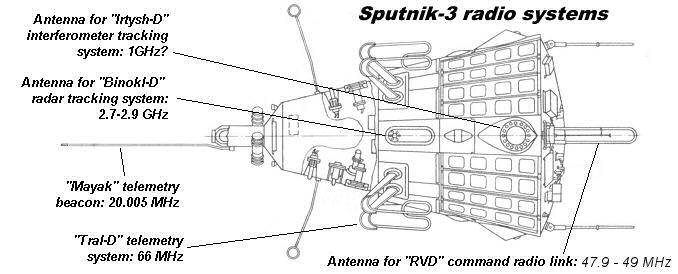

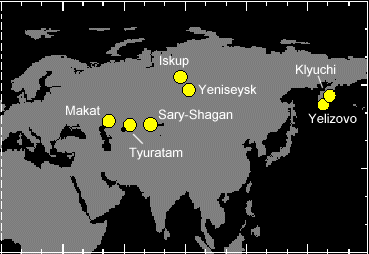 I
have heard Russian scientists describe that Korolev decided to launch
the
back-up satellite, which we now know as Sputnik 3, despite the fact
that
its telemetry tape recorder was suspected to be out of order.
Pre-launch
test indicated that the tape recorder was not operating properly. The
manager
in charge of the telemetry system and recorder, Chief Designer Alexei
F.
Bogomolov of OKB MEI, did not want to be the one to hold up this
important launch. Bogomolov insisted that the indications were due
to
electromagnetic interference from sources in the test area and that the
recorder worked properly. Perhaps the pressure from the Kremlin to
launch
made Korolev accept Bogomolov's explanation despite skepticism from
other
engineers and launch the back-up Object D. The Kremlin wanted the
satellite to be launched in time for the italian general
elections
on May 25-26, 1958. The idea was that such a display of the superiority
of Communism would help the Italian Communist party. In fact, it did
not
- the Italian communists did not increase its 23% share of the
electorate.
I
have heard Russian scientists describe that Korolev decided to launch
the
back-up satellite, which we now know as Sputnik 3, despite the fact
that
its telemetry tape recorder was suspected to be out of order.
Pre-launch
test indicated that the tape recorder was not operating properly. The
manager
in charge of the telemetry system and recorder, Chief Designer Alexei
F.
Bogomolov of OKB MEI, did not want to be the one to hold up this
important launch. Bogomolov insisted that the indications were due
to
electromagnetic interference from sources in the test area and that the
recorder worked properly. Perhaps the pressure from the Kremlin to
launch
made Korolev accept Bogomolov's explanation despite skepticism from
other
engineers and launch the back-up Object D. The Kremlin wanted the
satellite to be launched in time for the italian general
elections
on May 25-26, 1958. The idea was that such a display of the superiority
of Communism would help the Italian Communist party. In fact, it did
not
- the Italian communists did not increase its 23% share of the
electorate.
Since the apogee of Sputnik 3 was in the southern hemisphere and the Soviet Union only had tracking stations inside the country (see map derived from 1) the tape recorder was needed to gather detailed data on the radiation belts. The tape recorder indeed malfunctioned in orbit. In this way, Soviet scientists missed critical data needed to properly interpret the data that would have made them first in discovering discovering what is now called the van Allen belts (see more below)!
In (12) we can read:
"... Signals from the southern part of the orbit, where Sputnik III was passing through the inner radiation belt zone, still could not be received on the territory of the Soviet Union. The Soviet scientific vessel "Ob' " with a receiver on board was on its way to the Southern hemisphere, but it only arrived there and reported data first in September 1958. Also in September 1958 the Soviet Union shared its radio code with Australian researchers, who until that time were able to receive but not to interpret the signals from Soviet Sputniks (Hess, 1968 [13]). From September 1958 on, information from both the northern and southern parts of the orbit could be received and analyzed by Soviet researchers. But when Vernov described his preliminary results in July 1958 at the Moscow Assembly of the International Geophysical Year Committee, he only had the data from the northern part... "The radio signals received in Australia must have been the HF beacon "Mayak" and it must have contained data that partly compensated for the loss of the tape recorder for the "Tral" telemetry system. Let me quote from (4):
"....Sputnik 3 passed over the Antarctic at an altitude of 1800 km where a larger flux intensity was observed than in the Northern Hemisphere....However, the ionization in the scintillation crystal amounted to 2 x 1010 eV/sec in the Antarctic area, indicating a rise in intensity of 40-fold...."Let me also quote from van Allen (5):
"...On a purely observational basis the Sputnik 3 data represented discovery of the earth's outer radiation belt inasmuch as they were acquired before those of Explorer 4 and Pioneer 3. However, the interpretation of Vernov et al did not encompass the idea of geomagnetic trapping....."In (5) there is also talk about a partial failure of the telemetry system on 17 June 1958. Van Allen discusses in detail who was "first" and gives a very balanced picture of the state of knowledge of trapped radiation belts in the 1957-58 time frame - recommended reading.
Bart Hendrickx wrote to me about these matters:
This is also described in (6). The designer of the experiment was Sergei Nikolayevich Vernov, a professor at Moscow State University. The experiment did detect high concentrations of electrons, but Vernov's interpretation was that the electrons came from the metal body of the satellite itself and had been released by collisions with high-energy cosmic particles. This misinterpretation was mainly caused by the malfunctioning tape recorder, which meant that the scientists only got information about electron distribution in a very limited portion of the satellite's orbit (while it was over Soviet territory) and did not get the general picture later provided by Explorer-1. To give at least some credit to Vernov the Van Allen radiation belts were long referred to in Soviet literature as the "Van Allen-Vernov radiation belts".
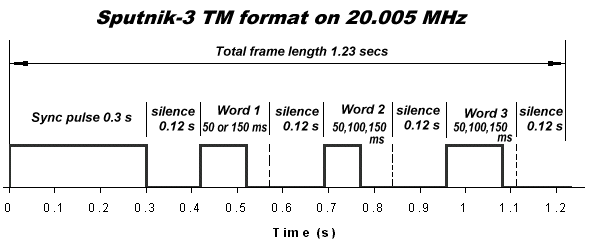 |
 |
I started a quest to find this "radio code" and started by contacting the World Data Center for rockets and satellites at the Goddard Space Flight Center and this is what R. Parthasarathy, Emeritus Professor of Physics, University of Alaska wrote in an e-mail on 17 February 2006:
"... I was deeply into monitoring and analyzing the Sputnik-3 (=1958 Delta-2) in Fairbanks, Alaska, to obtain 1) the total electron contentIn Basler's and deWitt's paper (8), which I obtained from the library of the Swedish Insitute of Space Physics in Kiruna, I finally found a reference to an article by Australian scientists Herz et al (9) where the telemetry code is revealed! In (9) we can read that the second and third pulses after the sync pulse carried information from the NaI scintillation counter (see sketch below). The information of the first pulse was unknown to Herz et al (see below). The anode current from the photomultiplier is integrated and triggers a bistable circuit that switches Relay A every time the NaI crystal has been subjected to 2 x 109 eV. The seventh dynode current controls Relay C in the same way every time the energy released in the NaI crystal is 18 x 109 eV.
by means of the signal's Faraday Rotation, and 2) the height of the F-region ionospheric irregularities that cause the signal strength to become jittery. They were published in the Proceedings of IRE (which later morphed into Proc. IEEE), Vol 47, p-78, 1959, and Vol 47, p-1660, 1959.While looking at the high-speed chart paper, my eye caught the structure of the pulses. They were obviously Pulse Width Modulated, may be a data stream. I alerted my Director at the Geophysical Institute, Dr. Christian T. Elvey, who contacted his friend/acquaintance Vernov in USSR and obtained the "code" that modulated the pulsewidth. The IGY hierarchy, operatives, and celebrities had a proclivity to hog the credit, but in this case it was strictly one-on-one rapport between Elvey and Vernov. I also recall that Vernov, et al., had also a paper on the radiation from Sputnik 3 in the Planet. and Space Sci,. 1959/1960?
Soon after, I moved on to other things, and left this radiation analysis to two graduate students, Ron DeWitt and Roy Basler. I recall they pursued it enough to publish a paper in JGR (?) some time in 1960/61 ?? [See 8]. To my memory, there was no other publication on the radiation telemetered by Sputnik 3 from any other American worker... "
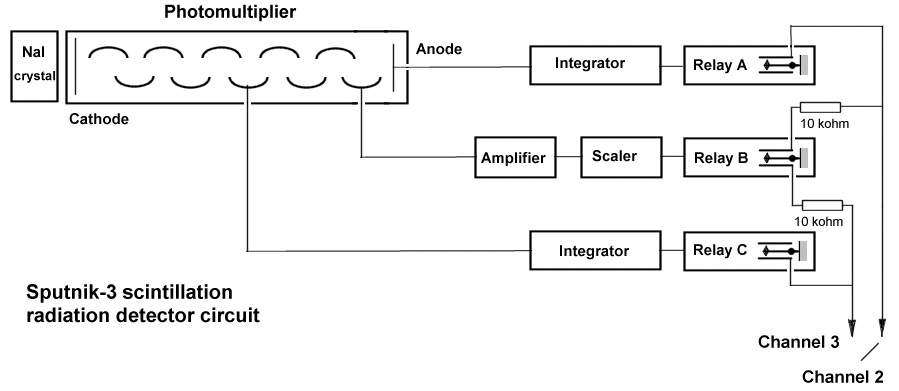
The last dynode was connected to Relay B via a scaler. On 17 June 1958 (5) Relay B froze in a fixed position, so Channel 2 corresponded to the anode current and Channel 3 corresponded to the seventh dynode current. The various combinations of positions of relays A, B and C led to pulse lengths of 50 msec, 100 msec or 150 msec, i.e. "short", "medium", and "long". However, when relay B "froze", channel 2 pulses were either long or short and channel 3 pulses were either short or medium length. Pulse lengths between these lengths occurred when the relays changed positions while a pulse was being transmitted.
The positions of the relays were sampled at the frame rate of 1.23 seconds. A change in the length of a pulse occurred when the number of realy switchings during the previous frame was odd. The pulse length does not change when the number of switchings are even - i.e. the relay returns to the original position (since it is a toggle switch). If the time between relay switchings is large compared to the frame length every relay switching leads to a change in pulse length. In (9) it is explained the "common sense suggests that the converse is also true: that changes in pulse-length at intervals large compared with the cycle length denote an equal number of switchings, each of which occurred during the cycle immediately preceding the change". In (9) there is also a graph that shows that the switching rate is not an unambiguous function of the interval between pulse length changes when the switching interval is less than the frame length. The pulse change interval varies very fast with changes in relay switching rate (for switching intervals less than the frame length). If, in such a situation, the switch rate fluctuates, the probability of long pulse-change intervals is low. Herz (9) also concluded that for switching intervals longer than the frame length the pulse-change interval is identical to the switching rate for the relay in question. Most of the time Herz (9) noted that the less sensitive channel 3 operated in this regime. For channel 2 the interval between pulse length changes rarely exceeded two frame lengths and it is was evident that the switching rate was less than the frame length. Therefore it was impossible to obtain directly an unambiguous value for the switching rate without additional information - in this case the difference in sensitivity between channels 2 and 3. In this way Herz et al were able to deduce the switching rate of both relays A and C.
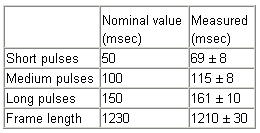 It
is interesting to note that the School of Physics at the University of
Sydney received a request from the USSR Academy of Sciences in June
1958 to record signals from Sputnik 3. They recorded signals on
20.005
MHz eight times between July 19 and August 4 1958. In September
19585
they received the details of the detection system to be able to decode
the telemetry. The conclusion in their paper is that they, in the
recordings
made in Sidney, is that they could detect the gap between the inner and
outer radiation belts. It seems that Vernov and his colleague were
trying
desperately to obtain data from the southern hemisphere by using the
Mayak
beacon when the tape recorder for the Tral telemetry system was out of
order.
It
is interesting to note that the School of Physics at the University of
Sydney received a request from the USSR Academy of Sciences in June
1958 to record signals from Sputnik 3. They recorded signals on
20.005
MHz eight times between July 19 and August 4 1958. In September
19585
they received the details of the detection system to be able to decode
the telemetry. The conclusion in their paper is that they, in the
recordings
made in Sidney, is that they could detect the gap between the inner and
outer radiation belts. It seems that Vernov and his colleague were
trying
desperately to obtain data from the southern hemisphere by using the
Mayak
beacon when the tape recorder for the Tral telemetry system was out of
order.
But what was the first
pulse?
I have in my files an article (16) by a
Swiss
gentleman named A. Fulpius, but the photo-copy has no mark as to the
publication's
name or date of issue. I think it is either Interavia or an ITU
publication.
In this article there is a little sketch of the Sputnik-3 signals as
that
above but it shows that pulse 1 (called word 1 on the figure above)
only
can take on short or long values, while the other two can take on all
three
values. In the caption of the little sketch we can read - in French: "La
première impulsion indique l'alimentation, soit en batteries
chimiques,
soit par cellules solaires". ("The first pulse indicates the power
supply,
either chemical batteries or solar cells").
It is interesting to note that Herz et al (9) also (just as I noted from the short signal sample above) found that the telemetry system did not perform exactly as specified. The pulse lengths and the frame length varied from time to time. This information is shown in the little table on the right.
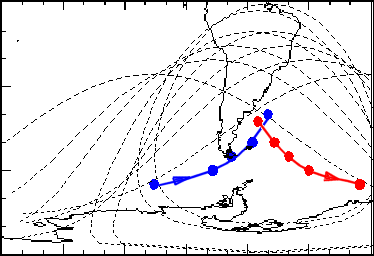 In
Vernov et al (15) there are many details
about
the instrumentation on Sputnik-3. The integrator and triggering
mechanism
for the relays described above turns out to be a capacitor that is
charged
by the photomultiplier current. A neon lamp across the capacitor
ignites
at a certain voltage and the voltage drops down to the extinction
voltage
of the lamp. In (15) we can also learn
that
the diesel-electric ship "Ob" received Sputnik-3 signals on 20 MHz
while
it was near South America. Interestingly Vernov's and Chudakov's paper
contains a graph of radiation data with a latitude/longitude scale
along
the abscissa. This information can be used to draw the ground tracks
for
these two passes near the ship "Ob". From the graph shown here (dotted
lines are radio horizons) it seems that "Ob" was near the southern tip
of South America.
In
Vernov et al (15) there are many details
about
the instrumentation on Sputnik-3. The integrator and triggering
mechanism
for the relays described above turns out to be a capacitor that is
charged
by the photomultiplier current. A neon lamp across the capacitor
ignites
at a certain voltage and the voltage drops down to the extinction
voltage
of the lamp. In (15) we can also learn
that
the diesel-electric ship "Ob" received Sputnik-3 signals on 20 MHz
while
it was near South America. Interestingly Vernov's and Chudakov's paper
contains a graph of radiation data with a latitude/longitude scale
along
the abscissa. This information can be used to draw the ground tracks
for
these two passes near the ship "Ob". From the graph shown here (dotted
lines are radio horizons) it seems that "Ob" was near the southern tip
of South America.
According to (4)
there was radio contact with Sputnik-3 until its decay after 691 days.
This is verified by A Fulpius, a radio amateur in Geneva (16).